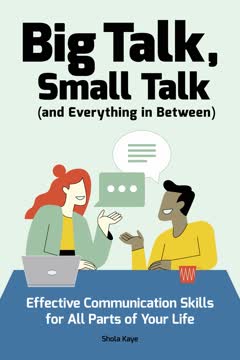Key Takeaways
1. Effective communication is a learnable skill essential for personal and professional success
Effective communication is a learnable skill.
Communication shapes relationships. From personal interactions to professional settings, our ability to convey ideas and emotions impacts every aspect of our lives. This skill set encompasses verbal and nonverbal cues, active listening, and the capacity to adapt our communication style to different situations and audiences.
Core communication competencies:
- Clarity in expressing thoughts and ideas
- Empathy and emotional intelligence
- Active listening and engagement
- Adaptability to various communication contexts
- Nonverbal communication awareness
Developing these skills can lead to improved relationships, career advancement, and overall life satisfaction. By practicing and refining our communication abilities, we can overcome barriers, resolve conflicts more effectively, and create stronger connections with those around us.
2. Small talk builds rapport and opens doors to deeper connections
Small talk gets a bad rap because some people see it as trivial or inconsequential. But sometimes small talk can pay off big.
Breaking the ice. Small talk serves as a social lubricant, easing tensions and creating a comfortable atmosphere for further interaction. It allows people to establish common ground and gauge each other's mood and receptiveness to deeper conversation.
FORM framework for small talk topics:
- Family
- Occupation
- Recreation
- Motivation
By mastering the art of small talk, individuals can more easily navigate social situations, network effectively, and create opportunities for meaningful connections. The key is to approach these conversations with genuine interest and openness, asking thoughtful questions and actively listening to responses. Remember that seemingly trivial exchanges can sometimes lead to significant personal or professional opportunities.
3. Body language and nonverbal cues speak louder than words
When we speak, we have so many choices about how we deliver our message.
Nonverbal communication dominates. Research suggests that up to 93% of communication is nonverbal, encompassing body language, facial expressions, tone of voice, and gestures. These cues often convey more about our true feelings and intentions than our words alone.
Key aspects of nonverbal communication:
- Facial expressions
- Eye contact
- Posture and body orientation
- Gestures and hand movements
- Tone and pace of voice
- Personal space and touch
By becoming more aware of our own nonverbal cues and learning to read those of others, we can significantly enhance our communication effectiveness. This awareness allows us to align our verbal and nonverbal messages for greater impact and credibility, as well as to pick up on subtle cues from others that might contradict their spoken words.
4. Active listening and empathy are crucial for meaningful conversations
Active listening involves being present to the speaker and minimizing the thoughts going on in our heads.
Listening to understand. Active listening goes beyond simply hearing words; it involves fully engaging with the speaker, seeking to comprehend their message and underlying emotions. This skill requires focused attention, patience, and the ability to set aside our own thoughts and judgments temporarily.
Components of active listening:
- Giving undivided attention
- Showing interest through verbal and nonverbal cues
- Reflecting and paraphrasing to confirm understanding
- Asking clarifying questions
- Withholding judgment and avoiding interruptions
Empathy, the ability to understand and share the feelings of another, complements active listening by allowing us to connect on a deeper emotional level. By practicing these skills, we can build stronger relationships, resolve conflicts more effectively, and gain valuable insights from our interactions with others.
5. Difficult conversations require tact, preparation, and emotional intelligence
When you need to apologize, there's a time to speak and a time to keep quiet and listen.
Navigating challenging dialogues. Difficult conversations, whether they involve delivering bad news, addressing conflicts, or discussing sensitive topics, require careful planning and execution. The goal is to communicate effectively while maintaining respect and preserving relationships.
Strategies for handling difficult conversations:
- Prepare and plan key points in advance
- Choose an appropriate time and setting
- Start with a positive or empathetic statement
- Use "I" statements to express feelings and concerns
- Listen actively and acknowledge the other person's perspective
- Focus on finding solutions rather than assigning blame
- Be willing to compromise and find common ground
Emotional intelligence plays a crucial role in managing these conversations. By recognizing and regulating our own emotions, as well as empathizing with others, we can navigate challenging discussions more effectively and achieve better outcomes.
6. Written communication demands clarity, brevity, and thoughtful presentation
Mark Twain famously said, "I didn't have the time to write a short letter, so I wrote a long one instead."
Crafting effective messages. In an era of information overload, the ability to communicate clearly and concisely in writing is more important than ever. Whether composing emails, reports, or social media posts, the goal is to convey your message efficiently and effectively.
Tips for improving written communication:
- Know your audience and tailor your message accordingly
- Use clear, concise language and avoid jargon
- Organize information logically with headings and bullet points
- Proofread for grammar, spelling, and clarity
- Consider the visual presentation (formatting, images, etc.)
- Be mindful of tone, especially in digital communication
Remember that different mediums may require different approaches. For example, a formal business report will have a different style and structure than a quick email or text message. Always consider the context and choose the most appropriate format and tone for your message.
7. Social media and digital communication require careful consideration of tone and permanence
Social media is powerful because so many people can see your messaging, but it's important to remember that social media can also create a very public and lasting perception of you.
Digital footprint awareness. In the age of social media and instant communication, our words can reach a global audience in seconds and potentially remain accessible indefinitely. This reality requires a heightened level of thoughtfulness and responsibility in our digital interactions.
Guidelines for responsible digital communication:
- Think before you post – consider potential consequences
- Be aware of your tone and how it might be interpreted
- Respect others' privacy and obtain permission before sharing
- Use appropriate privacy settings on social media platforms
- Be cautious about sharing personal information online
- Remember that even deleted posts may be archived or screenshotted
By approaching digital communication with mindfulness and respect, we can harness its power to connect and share ideas while avoiding potential pitfalls. It's crucial to maintain a positive online presence that aligns with your personal and professional goals.
8. Adaptability in communication style is key to navigating diverse situations
Without Words: There are many ways we can behave thoughtfully without speaking.
Flexibility in approach. Effective communicators understand that different situations and audiences require varying communication styles. The ability to adapt our approach based on context, cultural differences, and individual preferences is crucial for success in both personal and professional settings.
Factors to consider when adapting communication style:
- Cultural norms and expectations
- Professional vs. personal contexts
- Age and generational differences
- Power dynamics and hierarchies
- Individual communication preferences
- Emotional state of the audience
By developing a repertoire of communication strategies and the ability to read social cues, we can tailor our approach to maximize understanding and rapport. This adaptability allows us to navigate diverse environments more effectively, from casual social gatherings to high-stakes business negotiations.
Last updated:
Review Summary
Big Talk, Small Talk (and Everything in Between) receives an overall rating of 3.64 out of 5 based on 14 reviews on Goodreads. Readers find the book to be a useful manual for reference, offering helpful advice for communicating with various people in different circumstances. One reviewer gave it 4 out of 5 stars, praising its practicality. The book appears to provide valuable insights and strategies for improving communication skills across a range of situations, making it a potentially beneficial resource for those looking to enhance their interpersonal interactions.
Similar Books





Download PDF
Download EPUB
.epub digital book format is ideal for reading ebooks on phones, tablets, and e-readers.




